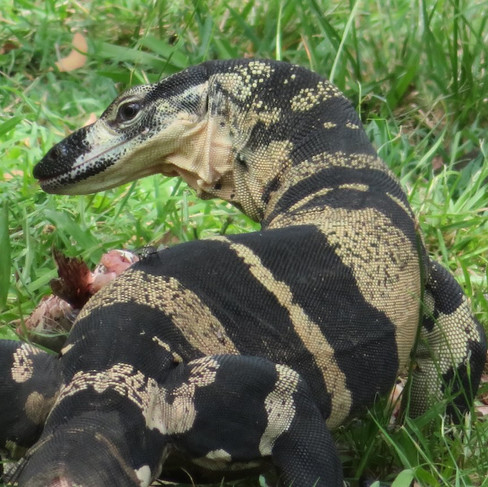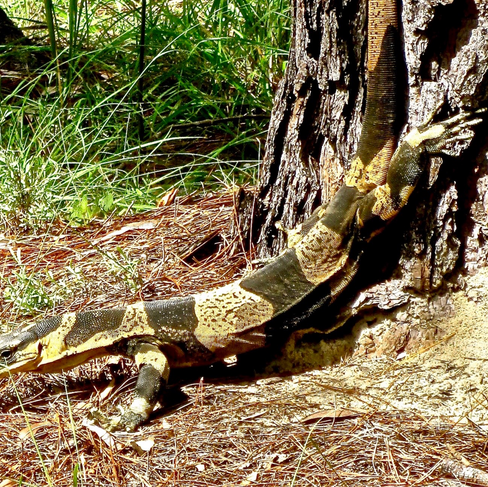We call her Jac ...
- Ian
- Mar 28, 2022
- 5 min read
Updated: Apr 25, 2022
Goanna (Varanus varius)
She was distinctive from the start. Being a goanna with only three legs is a bit unique. At first we assumed it was a male and called him Jake until we witnessed a larger goanna mount her. We changed her name to Jac, short for Jacquie. Goannas are a protected species in Australia.


Jac first turned up around twenty five years ago. At that stage we only came here camping and for holidays and she would turn up every year over the summer, wandering through the camp site with her distinctive gait, dragging her stump through the sand leaving a tell tale pattern.
Jac is a lace monitor commonly called a goanna, or more formally Varanus varius. She comes from the ancient lineage of lizard having evolved around 90 million years ago arriving in Australia around 15 million years ago. There are 69 living species around today. The largest is the Komodo dragon and is the closest living relative of the lace monitor.
Diet
Jac is a carnivore and scavenger. Something that has worked well for the species in Australia where they found a niche and thrived, evolving into a number of different species depending upon the environment they are living in.
Jac and her goanna friends feed on carrion, a wide variety of insects, eggs, young birds, mammals and the occasional bone we throw her. They can consume large items. One time camping our here we had T-bone steaks for dinner. Jac came through the camp site and took a bone which we had carelessly left on the ground. We were horrified to watch as she moved the bone around until she could get it in her mouth, even moving to a close tree and knocking the bone around eventually getting it down. We seriously thought that we would have to remove the partially swallowed large and sharp bone but she got it down.
Smart Goanna
Goannas are very smart animals as we found having chooks out here in the bush. They will easily take a chick while fairly young and we have lost several over the years. They also love eggs. We have had a battle of the minds with trying to keep out the goannas from the chook pen where the hens lay. The largest goanna we have here found its way into the pen by jumping through the hatch we had for the chooks to enter.
Goannas can jump
We eventually built an elaborate entry hatch which allows a hen to walk through the hatch which is made of a sheet of metal on a see saw. A goanna can't grip metal and the see saw tips which causes the heavy goanna to slide off! Thats the theory. Happily only one goanna has managed to gain access inside the pen since installation of security upgrade unit BB23!
Types of lace monitor
There are two forms or phases of goanna here. The Bells phase lace monitor has distinctive brown and cream bands running about their body. They are stunning creatures.
Bell's phase lace monitor.
Jac is the main type of lace monitor with cream spots and black and cream bands.
Lace monitors

Goannas shed their skin revealing clear and distinct colouring which fades over time until the next moult.
If you read up about goannas it is generally estimated that they live 10-20 years in the wild but of course it is difficult to be able to know how old a wild goanna is. Jac, being her distinctive self, has been identified to be well over 20 years old. She is getting older and slower as the years pass. It is always a delight to see her show up after winter.

Goannas partly hibernate during the colder months. They find a hollow log or other suitable habitat to sleep away the winter only to come out on really warm days taking the opportunity to search for food. Like all reptiles, goannas are cold blooded and use the sun to help warm themselves. It is not uncommon to see a goanna up a tree stretched out as they take in the last rays of the sun in the afternoon.

These days Jac appears to be losing her sight. She still manages to find her way around the bush and uses her long forked tongue to pick up the scent of food and familiar places around her.


Goannas range over a considerable area. Our neighbours a couple of kilometres away called us one day to let us know that they had just seen Jac at their place. They cover their territory, seemingly randomly wandering through the bush in search of food. I am sure it isn’t random. We can have three or four of these large lizards here on a single day, each wandering around. We have names for many of them usually from something distinctive, like Stumpy tail who has lost a bit off the end of his tail and Kinky tail who has a bend towards the tip of its tail. Then there's Pretty face. No imagination required.
Goannas are quite comfortable in the water too. We watched in amazement as a goanna walked into the fair sized pond close to the house and came out covered in mud with an eel in its mouth!

Lace monitors are also called tree goannas due to their excellent climbing ability. Their long claws and strong limbs allow them to climb straight up the trunks of trees or even more amazing straight down a trunk. They use this talent to search out birds nests to take the eggs or young chicks. If threatened they will run up the closest tree to escape predators. Jac is not so good at that with only three legs but does manage to go up trees a little way.

Goannas lay up to ten eggs usually in termite mounds. These mounds are temperature managed by the termites making them ideal for eggs to incubate. This takes 6-7 months over the winter, hatching in spring. We see young ones move through the area in early spring as the days begin to warm.
Sand goannas (Varanus gouldii) also live in the area but are not as common as the lace monitor.

Our Friend Jac
Jac turns up here most days in the warmer months to sun herself on the concrete or a handy log. She's getting slower every year and we think she might now be blind. We do give her a bone or an egg occasionally. She finds it difficult to locate the food thrown to her. It is not a good idea to feed these animals but Jac being so old and part of the land we feel she is part of our family.
When winter approaches Jac will disappear into the bush, sheltering in a log to sleep away the cold days until the warm sun brings her back out in search of food. We always look forward to seeing her in the spring.

Vale Jac
We found the body of Jac today, April 7 2022.
She was so special to us being the one animal that we have known here at Istari since the late 1990s.
As mentioned in our blog she was quite old and probably blind. We don't know how she died but it was possibly in one of the several floods we have had recently as we found her near the wetland where it had flooded.
She had an amazing life and will be remembered fondly.
Vale Jac.
Links
See our earlier blog on Goannas
See our Flood blog where Terry rescues Jac from the flood
Some helpful links to more information on the goanna.
Edited by Terry



































Comments